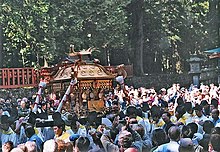Shinko-shiki


Shinko-shiki (神幸式), also known as Shinko-sai (神幸祭) is a shinto ritual of moving a kami in a procession.[1] The Kami's shintai will be removed from the main Shinto shrine and be put in a movable shrine such as Matsuri float or a Mikoshi.[1][2] It usually takes place during an annual festival for a shrine[2] The parade is considered a way for the kami to review and affirm the boundaries of a neighborhood or parish.[3]
The content, formality, and participation in Shinko Shiki parades vary depending on the region.[3] The most visible part of the parade is a group of marchers who walk or ride along a set route. The parades require organization and resources, and they are often organized as part of a shrine's ritual or related activities.[3]
The parades serve as affirmations of social boundaries because individuals and households contribute time and resources to their neighborhood or area's parade, participate in its organization or performance, and publicly display their membership through signs, posters, or jackets.[3]
This festival can take place on land or water, and the route and places visited are based on tradition. The festival can also include costumes and special rituals. It is sometimes called "O-watari" (お渡り) .[1]
The Gion Festival of Yasaka Shrine is a famous example of Shinko-sai.[1]
Shinko Shiki is specifically associated with the visit of kami to its parishioners, but there is a wide range of performance and interpretation.[3]
For example Tokyo Shinko-shiki is rowdy and has lots of drinking, while in Yuzawa it is quiet and formal.[3]
Related pages
[change | change source]References
[change | change source]- ↑ 1.0 1.1 1.2 1.3 https://archive.today/20230411204108/https://d-museum.kokugakuin.ac.jp/bts/detail/?id=3951
- ↑ 2.0 2.1 "Shinkō-sai | Britannica". www.britannica.com. Retrieved 2023-04-11.
- ↑ 3.0 3.1 3.2 3.3 3.4 3.5 Ashkenazi, Michael (1993-03-01). Matsuri: Festivals of a Japanese Town. University of Hawaii Press. ISBN 978-0-8248-1421-2.